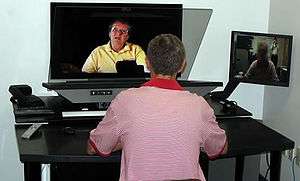History of videotelephony

The history of videotelephony covers the historical development of several technologies which enable the use of live video in addition to voice telecommunications. The concept of videotelephony was first popularized in the late 1870s in both the United States and Europe, although the basic sciences to permit its very earliest trials would take nearly a half century to be discovered. This was first embodied in the device which came to be known as the video telephone, or videophone, and it evolved from intensive research and experimentation in several telecommunication fields, notably electrical telegraphy, telephony, radio, and television.
The development of the crucial video technology first started in the latter half of the 1920s in the United Kingdom and the United States, spurred notably by John Logie Baird and AT&T's Bell Labs. This occurred in part, at least with AT&T, to serve as an adjunct supplementing the use of the telephone. A number of organizations believed that videotelephony would be superior to plain voice communications. However video technology was to be deployed in analog television broadcasting long before it could become practical—or popular—for videophones.
Videotelephony developed in parallel with conventional voice telephone systems from the mid-to-late 20th century. Very expensive videoconferencing systems rapidly evolved throughout the 1980s and 1990s from proprietary equipment, software and network requirements to standards-based technologies that were readily available to the general public at a reasonable cost. Only in the late 20th century with the advent of powerful video codecs combined with high-speed Internet broadband and ISDN service did videotelephony become a practical technology for regular use.
With the rapid improvements and popularity of the Internet, videotelephony has become widespread through the deployment of video-enabled mobile phones, plus videoconferencing and computer webcams which utilize Internet telephony. In the upper echelons of government, business and commerce, telepresence technology, an advanced form of videoconferencing, has helped reduce the need to travel.
Early history: 1876–1968
Videoconferencing: 1968 to present
Webcams: 1991 to present

| Wikimedia Commons has media related to Webcams. |
Telepresence: 1993 to present

The term telepresence was coined in a 1980 article by Minsky, who outlined his vision for an adapted version of the older concept of teleoperation that focused on giving a remote participant a feeling of actually being present at a different location.[1]
The first commercially successful telepresence company, Teleport (which was later renamed TeleSuite), was founded in 1993 by David Allen and Herold Williams.[2] Before TeleSuite, they ran a resort business from which the original concept emerged, because they often found businesspeople would have to cut their stays short to participate in important meetings. Their idea was to develop a technology that would allow businesspeople to attend their meetings without leaving the resorts so that they could lengthen their hotel stays.

Hilton Hotels had originally licensed to install them in their hotels throughout the United States and other countries, but use was low. The idea lost momentum, with Hilton eventually backing out. TeleSuite later began to focus less on the hospitality industry and more on business-oriented telepresence systems. Shareholders eventually held enough stock to replace the company's original leadership, which ultimately led to its collapse. David Allen purchased all of the assets of TeleSuite and appointed Scott Allen as president, and Brian Kinne as Executive Vice President [3] of the new company called Destiny Conferencing.
Destiny Conferencing licensed its patent portfolio to HP which became the first large company to join the telepresence industry, soon followed by others such as Cisco and Polycom.[4] After forming a distribution agreement with Pleasanton-based Polycom, Destiny Conferencing sold on January 5, 2007 to Polycom for $60 million.
An important research project in telepresence began in 1990. Located at the University of Toronto, the Ontario Telepresence Project (OTP) was an interdisciplinary effort involving social sciences and engineering. Its final report stated that it "...was a three year, $4.8 million pre-competitive research project whose mandate was to design and field trial advanced media space systems in a variety of workplaces in order to gain insights into key sociological and engineering issues. The OTP, which ended in December 1994, was part of the International Telepresence Project which linked Ontario researchers to their counterparts in four European nations. The Project’s major sponsor was the Province of Ontario, through two of its Centres of Excellence—the Information Technology Research Centre (ITRC) and the Telecommunications Research Institute of Ontario (TRIO)." [5]
See also
| Look up Videophone in Wiktionary, the free dictionary. |
| Wikimedia Commons has media related to Videophones. |
| Wikimedia Commons has media related to Videotelephony. |
| Wikimedia Commons has media related to Videoconferencing. |
- History of mobile phones
- History of radio
- History of telecommunication
- History of the telephone
- History of television
- List of video telecommunication services and product brands
- Telepresence
- Timeline of communication technology
- Timeline of the telephone
- Videoconferencing
- Videophone
- Webcam
Notes
References
- ↑ Marvin Minsky (June 1980). "Telepresence". Omni.
- ↑ Human Productivity Lab Whitepaper
- ↑ http://www.telepresenceoptions.com/2008/07/one_on_one_with_glowpoint_ceo//
- ↑ Telepresence: Ready For Its Close-Up, Mar 17, 2008, Dawn Bushaus
- ↑ Final Report
Bibliography
- Burns, R.W., Television: An International History of the Formative Years IEE Publication Series, Institution of Electrical Engineers, Science Museum (Great Britain), 1998, ISBN 0-85296-914-7, ISBN 978-0-85296-914-4
- Mulbach, Lothar; Bocker, Martin; Prussog, Angela. "Telepresence in Videocommunications: A Study on Stereoscopy and Individual Eye Contact", Human Factors, June 1995, Vol.37, No.2, p. 290, ISSN 0018-7208, Gale Document Number: GALE|A18253819. Accessed December 23, 2011 via General Science eCollection (subscription). This study in turn cites:
- Norby, K. "A Window To The Future: The Videophone Experience In Norway", Kjeller, Norway: Norwegian Telecom Research Department, 1991, pp. 66-77.
Further reading
- Les premiers travaux britanniques sur la vision à distance (1880-1881): J. Perry, W.E. Ayrton, G. Middleton, S. Bidwell, History of Television website. (French)